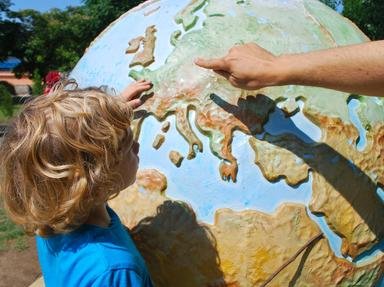Quiz Answer Key and Fun Facts
1. This strange-looking creature is a gharial, or fish-eating crocodile. Native to only one country in the world, you might see one at Kaziranga National Park, which is in a state that also produces a famous black tea. Where must we go to see this curious animal?
2. Rising some 22,837 feet above sea level, Mount Aconcagua is the highest point on Earth outside Asia. To which country, the home of the Pampas and the steppes of Patagonia, must you go to climb this great mountain?
3. Bryce Canyon is one of my favorite National Parks in the USA. Other National Parks in the same state include Capitol Reef, Canyonlands, Zion and Arches. In which US state, also known for a large lake, can you see this spectacular sight?
4. You've probably all heard of Old Faithful, the famous geyser in America's Yellowstone National Park. The photo here is of Strokkur in the Haukadalur valley, home of the world's oldest known geyser. Where must you go to visit both this wonderful sight and the other amazing geothermal features of the area?
5. This is the endangered golden monkey (Cercopithecus kandti), found only in the fruit and bamboo-rich highland forests of the Virunga volcanic mountains of central Africa. Colonies of golden monkeys exist in four national parks, Mgahinga, Volcanoes, Virunga and Kahuzi-Biéga. In which country can you NOT see this rare creature?
6. Peaking at 9,177 feet, Mount Ruapehu is one of the world's most active volcanoes and the largest volcano on its island country. The photo shows the mountain in the background with verdant fields full of sheep, where one can almost imagine Hobbits sitting under a tree smoking their pipes. Where are we visiting now?
7. The city of Samarra was the capital of the Abbasid Caliphate for most of the 9th century and is only remaining Islamic capital with the original architecture and relics. The Great Mosque of Samarra (pictured) was completed in 851 and for a time was the world's largest mosque. In which country can you see this sight?
8. This spectacular view is of Angel Falls, the world's highest uninterrupted waterfall which has an uninterrupted plunge of plunge 2,648 feet. It is located within Canaima National Park in one of the most bio-diverse countries in the world. Where must you go to see this great sight?
9. This magnificent bird is the purple-crested turaco, a cousin of the cuckoo family, and is found throughout much of central and southern Africa. The national bird's flight feathers are a vital part of the Royal family's ceremonial regalia in which former British protectorate, one of Africa's smallest countries?
10. The 449-foot high sea stack that dominates the photograph is known as "The Old Man of Hoy" as he guards the western shore of the island of the same name. Formed of Old Red Sandstone, it was created by erosion from the sea and will eventually collapse completely beneath the waves. To which island group must you travel to climb the old man?
Source: Author
EnglishJedi
This quiz was reviewed by FunTrivia editor
NatalieW before going online.
Any errors found in FunTrivia content are routinely corrected through our feedback system.


